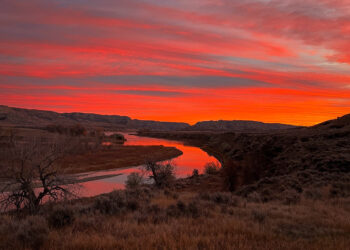By Marne Hayes EBS COLUMNIST

When the Gallatin River Task Force approaches projects around river restoration, it thinks of protecting habitat, improving access, repairs to riparian areas, fixing erosion and generally adding to the health of a river and watershed. But what does that all really mean? There are nuances to the scope, size, desired outcome, cost, oversight, challenges, and an entire gamut of possibilities for improvement.
Every project is different; The parameters of restoration are wide, depending on the needs of the site/river, what the uses for the location are and what kind of permitting and/or budget needs to be considered. The primary goal of any restoration project is to, as it states, restore.
Something has been degraded, and it needs help to get back to the original, healthy state. Ideally the goal is to return to the closest version of a river’s historical context—how it was before overuse, excessive flows, pollutants, etc. became a factor; This isn’t always possible, but becomes the desired benchmark.
An example of this along the Gallatin River is the Deer Creek access site. There had never previously been a parking lot, but it was necessary to bridge the gap between the extensive network of visitor-created river access roads and the health of the river. By adding a designated parking area, boat ramp, pathways, etc., it created an optimal situation for the restoration site to get the care that it needs (replanting the riparian buffer) while also allowing people to recreate and access the river without additional damage to the banks. By adding designated areas for recreation, it limits the amount of traction and strain being put on the rest of that area.
Some would ask, “Why not just let nature do its job?” even if that means erosion or other forms of naturally occurring degradation. While nature is resilient and typically very good at “doing its job,” it’s unable to keep up with the degradation that is happening in and around our waterways at the rate in which it is happening.
An example of restoration where the task force has allowed nature to do its job is utilizing Low-Tech Process-Based Restoration techniques. It involves no, or very little, machinery and relies on the natural processes to take over. An example of this in Big Sky is the Middle Fork of the Gallatin River, where there was no actual conventional construction, but natural elements of the areas around the streambank (like branches) were moved around and provided structure to the stream. Nature just needed a little push to start the natural processes, and after a few years the river will adapt.
It sounds logical, but nothing in restoration happens overnight. When a buffer is replanted, or a beaver dam analogue is added to a stream or additional improvements are made, it takes a lot of time for those
to take hold. The plants need to grow and the river needs to adapt to its new structures—it is not an immediate process.
However, by starting the project and steering overuse away from these areas, the degradation has been allowed to stop. At Deer Creek, the new plants may take years to mature. But no longer having vehicles driving on that area is going to make a huge immediate difference from an erosion and sediment standpoint.
The site has been allowed to start growing and moving back to its natural context. As riparian buffers grow the roots will get deep and help stabilize the riverbank. The trees will grow tall and provide shade to keep the water cooler. Essentially, you have stopped that area from experiencing further damage—which is the starting point.
A healthy river and recreation can co-exist but people need to be encouraged to do so responsibly. By implementing elements of restoration that improve access, you deter people from paving their own way to the river. When someone drives up to a newly discovered fishing spot, another person’s curiosity is piqued, and another, and so on. Eventually, the ground has taken enormous impact and the plants have died, the soil erosion is subject to damaging runoff and the landscape will erode.
Restoration projects, and the relationship between use, naturally occurring elements, degradation and restorative projects is a balance. At its core, restoration is largely about “people management.” The river is smart, and naturally works to be healthy. Our part is to listen to science, be good stewards, treat the river kindly and work to fix the problems that people have created.
Marne Hayes is the communications manager for the Gallatin River Task Force.













